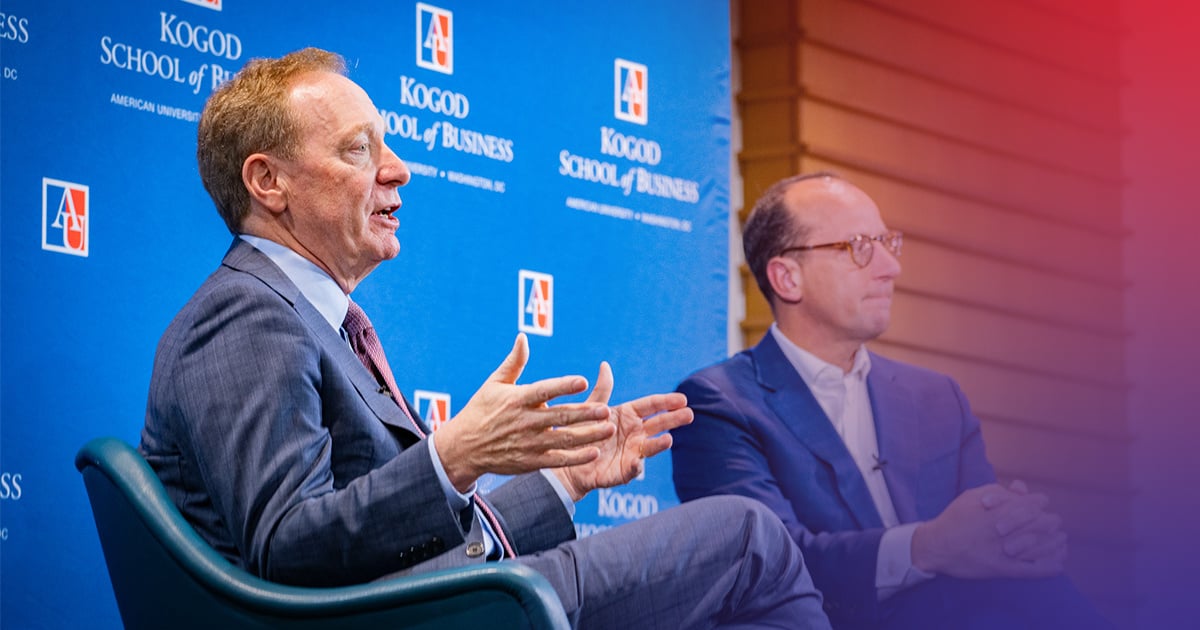
Darby Joyce
Content Marketing Coordinator
Brad Smith knows a thing or two about the rise of new technologies.
Having worked at Microsoft for over thirty years, he saw the company grow through the information age and the birth of the modern Internet to become the giant it is today. Now the company’s president and vice chairman, he’s turning his attention to what he—and many like him—believes is the next great technological advancement.
Prior to his visit to American University earlier this month, Smith likened artificial intelligence to the invention of the printing press and the widespread adoption of electricity. Within the discussions around AI, he sees the potential for new jobs and industries, streamlined solutions to problems in business, technology, and beyond, and learning opportunities across disciplines. As he explained to a packed room in the university’s McKinley Building, he believes that artificial intelligence is the next significant general purpose technology, or GPT—a technology that serves many functions, much like electricity.
It only follows that Smith would come to AU to talk about the future of AI. The Kogod School of Business was one of the first schools in the country to integrate AI education and training into its curriculum and remains one of the only business schools to do so. Students are already utilizing AI in their projects, experimenting with new tools, and networking with experts in the field, an approach that Smith says is key to making it more widely accessible.
You need to build an infrastructure to bring a new technology to everyone, but you also need to help people understand how it can be used and equip them with the knowhow to put it to work.”

Brad Smith
President and Vice Chairman, Microsoft
As an understanding of AI grows, Smith has taken note of two emerging disciplines that may very well be taught in business schools in the years to come. AI engineering combines computer and data science with regulation, risk management, and a focus on questions of responsibility and ethics in artificial intelligence. Meanwhile, AI systems management involves training people in using AI tools and identifying business processes that could benefit from them. With AI training and hands-on use of existing tools woven into the Kogod curriculum, students are now preparing early for careers that may arise in these disciplines by developing AI fluency—a skill Smith believes will soon be crucial to include on resumes. He likened current experimentation with AI tools to his own experiences with personal computers during his early career, recalling that he became a better and faster writer at his law firm as a result of trying new things with his computer.
“I just got excited about using my PC, and I tried using it in different ways. Some of them worked, and some didn’t,” he explained. “The more you can do that, the better you will be for the rest of your life.”
Though trying new things in regards to artificial intelligence is crucial to understanding it, Smith is also making sure that Microsoft looks to the history of technology and avoids making the mistakes of the past. In keeping with his comparison to the adoption of electricity, he explained that while homes became electrified quickly in urban centers, rural areas were often overlooked before 1936’s Rural Electrification Act. Beyond the borders of the United States, these discrepancies were even wider—and remain unresolved. Electrical infrastructure was only introduced in much of Africa to benefit the work of colonial powers there, and 43 percent of the African population remains without regular access to electricity today. If artificial intelligence is truly to become widespread and to focus on benefiting people globally, Smith says, this inequity can’t be repeated.
To invent a general purpose technology that can change people’s lives, that can literally bring light into a dark room, and then to take 150 years before we can say we have electricity for everyone—that is the great cautionary tale.”

Brad Smith
President and Vice Chairman, Microsoft
So, what is Microsoft doing to ensure fair, responsible, and accessible AI usage? At the core of their mission is partnerships. To fully understand AI’s impact, Smith knows that developing it can’t occur in a technological bubble; it needs the perspectives of the schools that teach it, the unions whose jobs will be tied in with it, the law experts who will determine how to regulate it, and the international organizations who will oversee its global impact.
“Part of what needs to happen for this new approach is a much broader approach to partnering with people, governments, academia, business, labor, and civil society,” Smith said. “We need to do this in a way that doesn’t look to it happening in a single country alone. It needs to bring the world together.”
This focus on responsible AI use struck a chord with the students at the event. During the question-and-answer segment of the event, one MBA student asked Smith how Microsoft will realistically balance its goal of being carbon-negative by 2030 with the power generation demands of its AI ambitions—a testament to the student base’s commitment to sustainability in business. Smith’s answers include prioritizing carbon-free energy sources, working with international partners to ensure that they also prioritize sustainable energy, and creating an innovation fund to support organizations creating greener infrastructure for steel and concrete production.
Listening to students’ questions during the event—whether they were addressing the need for sustainable AI development, asking about Microsoft’s current projects, or looking for advice on where to get started experimenting with AI—underscored Smith’s core idea that AI is for everyone. As he explained during his presentation, artificial intelligence functions in a technology stack similar to electricity’s; successful AI infrastructure includes data centers, land and power, applications, and development, all of which need experts to ensure everything works properly. Smith’s message that AI can only avoid electricity’s failings by bringing in perspectives from across countries, disciplines, and experiences was at home at the Kogod School of Business.
“If you think about everything involving AI, from the creation of the technology to its use and how you deal with the sustainability issues, there are extraordinary multidisciplinary challenges and opportunities,” Smith said. Fortunately, he was speaking to a university community with a deep interest in addressing those challenges and taking advantage of those opportunities.
